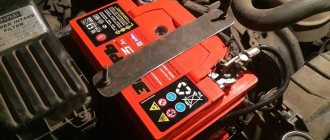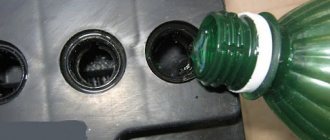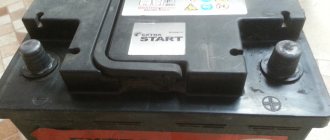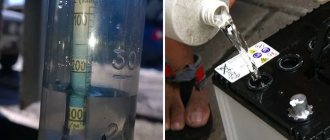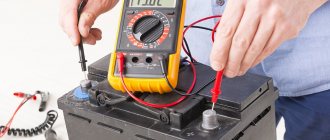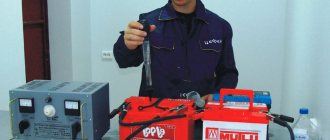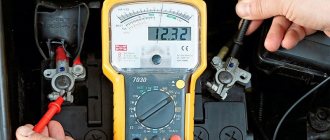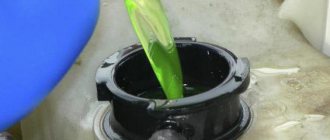For the normal operation of electrical appliances in a car, you need a suitable battery, the capacity of which will allow you to easily maintain the operation of the devices and at the same time start the engine. In order to have a sufficient supply of electricity, many car enthusiasts seek to install batteries of larger capacity. The best option for a middle-class passenger car is a 60 ah battery.
How much does a 60 Ah battery weigh?
A standard 12 volt battery 6ST-60 consists of six cans of equal volume, which contain lead plates, separators and electrolyte. The battery always weighs quite a lot. The main weight falls on the lead plates, but, in addition, a fairly large amount of acid solution, which is much heavier than water, is poured inside the product. The body of the product consists of dense plastic, the mass of which is relatively small, but also contributes to the total weight of the battery.
The total weight of a 60 A/h battery filled with electrolyte may vary slightly depending on the technology and manufacturer, but the average will be from 13 to 16 kg.
Rules for filling electrolyte
A sulfuric acid solution is poured into the battery according to certain rules that must be followed if you want the battery to last a long time:
- the liquid should cover the plates and be approximately 10-15 mm above their level; the electrolyte cannot be poured “up to the very neck”, otherwise it will boil and spill out;
- the density of the composition must be certain, corresponding to the season (in winter the density is always higher);
- Only distilled water is allowed to be added to jars; the electrolyte itself cannot be used as an additive; it can damage the battery;
- if the density is too low, the voltage at the terminals is below normal, the battery must be charged.
When working with sulfuric acid, you must wear rubber gloves and avoid getting the solution in your eyes or on your skin. If electrolyte does get in, you should immediately wash the contact area with running water. In this case, it is advisable to use special work clothes - if drops of electrolyte get in, the fabric is corroded and things become unusable.
Related Posts
Preparing the car for summer
Proper running-in of a diesel engine after overhaul
Installing car speakers yourself
To pour the sulfur solution, you must use special containers that are resistant to acid. When mixing water with acid in large quantities, heat is generated, so as not to accidentally suffer from splashes, a concentrated solution is always added to the water, and not vice versa. An exception is adding water directly to the battery, but here the electrolyte is not so concentrated, and it is located quite deep inside the battery case itself.
For which cars is a 60 Ah battery suitable?
Batteries with a voltage of 12 volts and a capacity of 60 Ah are suitable for installation in passenger cars whose engine capacity does not exceed 2 liters. As a rule, without any serious consequences, you can replace standard batteries with a capacity of 55 Ah, installed on domestic passenger cars. Provided that the battery is suitable in size and terminal location, increasing the storage capacity of the vehicle's on-board system current will lead to more confident operation, especially in city traffic jams and in the winter season.
If the car is equipped with a Start-Stop system, then you need to choose a battery made using AGM, GEL or EFB technology. They also withstand deep discharges very well and can be used as traction batteries, but they cannot be charged with a regular charger; you need a special one.
How much electrolyte is poured into batteries 75, 90 and 190 A/h
“Seventy-fifths” and “nineties” batteries are considered powerful for passenger cars; they are more often used in SUVs and premium cars with a lot of additional equipment (climate control, full power accessories, cruise control, headlight washers, etc.). Batteries require a fairly large energy consumption, so they must provide power to all consumers with a reserve.
Such batteries already weigh more significantly; a charged “75th” battery weighs about 20, and a “90th” battery weighs about 25 kg. To fill an empty case with electrolyte from a battery with a capacity of 75 Amp-hours, you will need from 3.7 to 4 liters of solution; approximately 4.4-4.8 liters should be poured into the “90th” battery. The 190 A/h battery is practically not used in passenger cars; it is intended for trucks, PAZ or KAvZ buses, and various special equipment. Such a battery without electrolyte can weigh 42 kg, and refilling requires up to 10 liters of sulfur solution. There are also batteries with a capacity of 110, 132, 140, 215 Ah; there are other ratings, but they are not so widely popular and widespread.
Which 60 Ah battery to choose and what to pay attention to
In order for the battery to last as long as possible, it is important to avoid deep discharges, protect the product from mechanical damage, and bring the product into a warm room when parking the car outside for a long time in winter. In addition, when purchasing, it is necessary to give preference to a trusted brand. The most popular among domestic and imported brands are:
| Domestic | Foreign |
| Beast | Varta |
| Tyumen | Mutlu |
| Tornado | Tab |
| Titan | Bars |
| Bison | Atlant |
| Akom | Gigawatt |
| Bear | Moratti |
| Magnum | Unikum |
| AutoFan | Westa |
| Dominator | Uno |
| Bolk | Fireball |
The listed brands have all the necessary advantages to provide electric current to modern cars, which are equipped with internal combustion engines with a volume of up to 2 liters.
Did you have or do you have a 60 Ah ? Then tell us in the comments which one and your impressions of it, this will greatly help other car enthusiasts and make the material more complete and accurate.
Determination of electrolytic fluid in a battery
There are two types of energy sources commonly used in the automotive industry today:
- Maintenance-free devices are enclosed in a sealed housing that completely prevents access from the outside. They, as a rule, exhaust their resource and must be replaced. You cannot restore their functionality on your own. The only thing the owner of such a battery can do is charge it as needed.
- Maintained - require constant attention and monitoring. It is necessary to regularly monitor the level of the electrolyte solution, as well as its density and the condition of the plates.
How to find out the electrolyte level
Electrolytic liquid can change its volume as it is stored and used. How can you check the electrolyte level in a battery? There are several options, each of which can be used in a specific situation:
- According to special marks applied to the body. Some energy sources have two horizontal lines parallel to each other on the outer surface of the housing in its upper part. The bottom one is marked “min” - shows the minimum possible level of the electrolyte solution. The top one has the inscription “max” - the maximum permissible limit of the liquid medium.
- By visual inspection. It allows you to determine the approximate amount of liquid content. In the absence of tags and other available means, it is enough to simply unscrew the plugs on the top cover of the case, while installing the device on a flat horizontal surface. Looking inside, especially if there is good lighting, you can understand by the following criteria whether the solution is enough or not:
- the plates are completely hidden by the liquid medium, there are no leaks on the outside of the case - the level is normal;
- the electrodes are visible (they are level or above the surface of the liquid) – topping up is required.
- By performing simple measurements. The electrolyte level in the battery can be checked using:
- Hydrometer device. It will allow you to find out the density of the liquid in each jar, which will make it possible to draw a conclusion about its quantity. We lower it into each hole one by one, draw up the solution using a bulb and look at the readings. If the value is higher than normal, then the level is insufficient.
- Available means: a transparent juice tube or the same body of a ballpoint pen. We lower the tube into the hole in place of the unscrewed cap until it rests against the top edge of the jar. We pinch the end remaining on the surface with a finger, thus blocking the flow of air into it. Holding your finger, remove the tube and measure the height of the column of liquid trapped inside it. At a normal electrolyte level, its value should be in the range from 11 to 15 mm.
Low battery electrolyte level
How can you tell if your battery has low electrolyte levels? This is very eloquently evidenced by:
- significant increase in density;
- the appearance of plates above the surface of the liquid medium.
There may be several reasons for this:
- Evaporation of distilled water is the most common factor in volume reduction in the summer. As is known, too high outdoor temperatures provoke evaporation processes. And when using the battery during this period, it is very hot under the hood.
- Liquid boiling over due to a malfunction of the temperature relay-regulator.
- As a result of battery discharge, some of the acid is consumed for electrochemical reactions.
A decrease in the electrolyte level below normal in the battery leads to very serious consequences:
- firstly, a solution of increased concentration promotes accelerated destruction of the plate material;
- secondly, that part of the electrode surface that is located above the liquid boundary undergoes sulfation.
In both cases, the outcome is the same: rapid loss of capacity and premature failure of the energy source. This means it will need to be replaced. Where is the guarantee that the new battery will not lose its functionality just as quickly?
Option one is to learn how to properly operate and maintain the battery, and first of all, maintain the liquid component at normal levels.
What should be the electrolyte level in the battery? The norm is when the electrolyte solution is 1–1.5 centimeters above the electrode plates, completely covering them when the car is moving. Moreover, the electrolyte level must be the same in each jar - this is very important for reliable battery operation.
In what volumes is electrolyte sold?
Now it’s not such a big problem to buy this liquid, you just need to sit down and go to a specialized store that sells batteries; it’s unlikely to be available in ordinary spare parts.
Basically it is sold only in two containers, these are 1 liter (bottle) and 5 liters (canister). If you were repairing, say, eliminating a short circuit, you only need to fill one jar, then 1 liter will be enough for you, as they say “for the eyes.” The cost ranges from 50 rubles for a liter bottle and up to 200 for five liters.
But if for some reason you need to change the entire volume, then it all depends on the size of your battery and its power.
If the density is below normal
When the density of the electrolyte in any of the cans is below normal, the battery will not work normally and will not be able to start the engine. There is an opinion that you should pour the liquid out of the battery and fill in a new sulfur solution, but this is not recommended - when the battery is turned over, particles of lead sediment from the bottom can short-circuit the plates, and then the battery will fail. There are several proven ways to restore density:
- charging the battery using a charger with a small current;
- electrolyte replacement - using a bulb, pump out some of the old liquid from the jar (which is located on top of the plates), add a fresh solution, the concentration may be even higher than normal;
- adding pure sulfuric acid, but this method is not popular.
If the density is still lost and it is impossible to restore it, there is no point in “revitalizing” the battery; it must be replaced.
Dependence of volume and current strength
It is clear that the volume of 45Am/h will be much less than that of the 190Am/h option. If you dig into the physics, a powerful battery requires more lead (which is placed in a more bulky case), which is why the dimensions of the 190 version will be almost 4 - 5 times larger than, say, the same 45. And where there is more of this metal, more electrolyte is needed to effectively accumulate voltage.
However, if you think about the question - how much do you need to buy in order to guess for all options (take it as if with a reserve), the answer suggests itself. After all, the maximum canister, which is sold in only five liters, is therefore suitable for almost all models. In order not to be unfounded, I want to analyze the most popular “Amperages”.
Let me make a reservation right away: there are slight differences depending on the manufacturer, but they vary by insignificant grams.
Importance of Density Values
The main parameter that determines the properties of the electrolyte is density. The parts of water and sulfuric acid in the solution must be contained in a certain proportion: an electrolyte that is too dense contributes to the rapid failure of the plates, and the sulfation process is activated.
If the density is less than the established norm, the battery may freeze in the cold winter; the reduced concentration of the solution contributes to the rapid discharge of the battery. To increase the density, the battery is charged; in winter, the electrolyte concentration should always be higher, and lower in warm times, especially in the heat. The density in the battery is measured with a hydrometer, the values are within the range:
- for the summer season - 1.23-1.25 g/cm?;
- in winter - 1.26-1.29 g/cm?.
For machines operated in the Far North, the density can reach higher values, but all these indicators are relative, and they can only be taken as a general recommendation. If you have no idea what concentration the solution in the battery should be, it is better to consult a specialist; there is conflicting information on the Internet and other media.
Battery sizes and types of terminals
To install a battery under the hood of your car, you must be familiar with the exact size chart of all types of suitable batteries, as well as the types of their clamps. It is advisable to familiarize yourself with the parameters not only of length and width, but also to find out the required height. So that the battery can fit exactly in its place.
A standard 60 Ah battery comes in three versions:
| Type of battery | Width, cm | Length, cm | Height, cm |
| Standardized | 17.5 | 24.2 | 19.0 |
| Short | 17.5 | 24.2 | 17.5 |
| Asiatic | 17.3 | 23.2 | 22.5 |
It is also worth considering the difference in terminal types to accurately select your battery. The following types of clamps can be installed by the manufacturer on a 60 Ah battery:
- Standardized. European and Russian batteries are most often equipped with such terminals. The diameter of the positive clamp is 19.5 mm, the negative clamp is 17.9 mm.
- Asian. Terminals of this type predominate on Asian cars. The shape of these clips protrudes upward from the outside of the battery. Here the positive clamp is 12.7 mm, and the negative clamp is 11.1 mm.
- American. These clamps are found on American cars made in the USA. They are standardly located on the side of the battery and have an internal thread. Such batteries are not compatible with European or Asian type clamps.
All batteries can be produced with direct and reverse polarity.
conclusions
The electrolyte level in a battery is one of its most important characteristics, which largely determines the reliability of operation and life cycle.
It is known what level of liquid should be in the battery - 1.0–1.5 cm above the upper edge of the electrodes. This must be strictly monitored and the plates must not be exposed, then there will be no problems with starting the engine.
The level of electrolyte and its density in each jar must be absolutely the same - this is necessary for the stability of its operation and uniform operational wear.
Reviews
Ruslan. Krasnodar city. I recently bought an Optima YellowTop 75 Ah 12 v. The battery was ideal for replacing a standard 70 Ah battery, while the technical characteristics of the new product significantly exceed the current characteristics of the old device.
Nazim. Rostov. Very good 75 Ah gel battery. The battery tolerates deep discharges well.
Maksim. Voronezh. I bought a higher-power battery because the old one couldn’t cope with starting a diesel engine in winter.
Charging safety
The most dangerous operation when charging a battery is disconnecting it from the charger. In some cases, this may cause an explosion. During charging, reactions occur to release hydrogen from the electrolyte. However, large professional chargers are more susceptible to such reactions.
Car owners or craftsmen who deal with chargers should not approach it with cigarettes or other types of fire. It is possible to disconnect the clamps only after completely disconnecting the charger from the power supply.
The final stage of working with the battery
The electrolyte level in the car battery has been checked and brought to normal. It remains to bring the battery itself into working condition:
- Wipe thoroughly and screw the plugs into place.
- We remove all smudges and drops from the case using rags and excluding skin contact with the electrolyte.
- If the solution gets on other surfaces or clothes, wash it off with water.
- We carefully monitor the energy source, promptly clearing its surface from any liquid that has spilled during operation of the vehicle.
What can you add to the battery?
To determine what to add to the battery, you need a special measuring device - a hydrometer. This is a glass tube with a bulb, inside of which there is a float. A scale indicating the density is applied to the outer wall.
Verification algorithm:
Checking the electrolyte level with a hydrometer.
- Charge the battery to 100%.
- After fully charging, wait 3-5 hours for the chemical reaction inside the cans to normalize.
- Unscrew the plugs (if the battery is maintenance-free, drill holes in the housing).
- Immerse the hydrometer in the jar and scoop up the electrolyte with a bulb.
- Take measurements in each section one by one.

